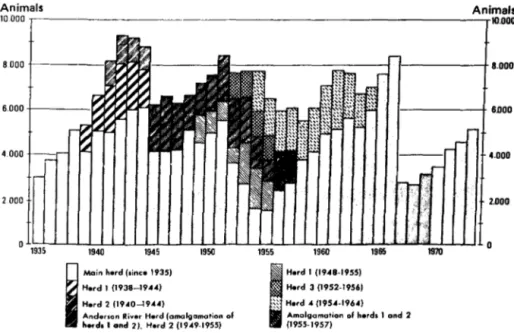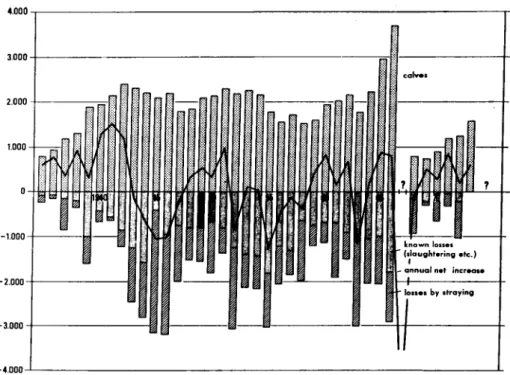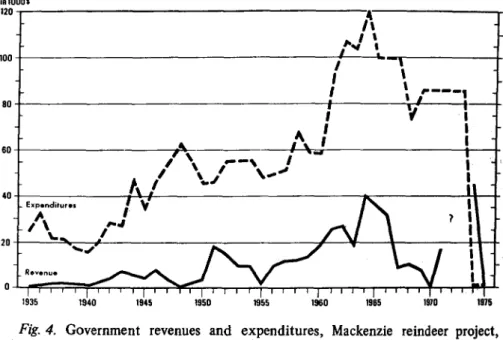FORTY YEARS OF REINDEER HERDING IN mE MACKENZIE DELTA,
N.W.T.
Erhard Treude
(Institute of Geography, University of Münster) From:
Polar[orschung,Vol. 45, No. 2, 1975, pp. 129-148.
Abstract: Reindeer herding in the Mackenzie Delta area started in March 1935, when a herd of 2,370 animals was delivered to the newly established Reindeer Grazing Reserve.
Conceived to supplement the dwindling wildlife resources of the Canadian Arctic and to improve the economic conditions of the native Eskimos, the policy was to keep a government-owned nucleus herd from which additional units could be obtained and put under Eskimo management. Several native-owned herds were set up, but for various reasons they all were retumed to the government, the last one in 1964. A new approach was undertaken in 1960; in an attempt to demonstrate the economic feasibility of an Arctic reindeer industry, the project was placed under private management. There were plans to start large-scale reindeer breeding following modern conceptions of reindeer husbandry, but when the reindeer population dropped alarmingly, the Canadian Wildlife Service in 1968 accepted the responsibility for a five-year term. The main task then was to rebuild the herd and to conduct biological as well as management-related studies. In March 1974, the herd was finally sold to a native-owned Reindeer Company. In addition to providing a detailed review of reindeer herding in the Mackenzie Delta area, an attempt is made to evaluate the past economic importance of the project and to assess its potential future development. (The translation is by Williarn Barr, University of Saskatchewan, Saskatoon.)
1. Introduction
The first attempt at introducing a reindeer industry, Le., the herding of semi-domesticated reindeer
(Rangi[er tarandus),into North America was made in the 1890's in Alaska. In an effort to help the Eskimo, whose existence was threatened by the ruthless exploitation of the stocks of game by American whalers, 1,280 reindeer were purchased in Siberia between 1891 and 1902 and were subsequently distributed over a wide area of coastal Alaska in the form of Eskimo-owned herds. The subsequent eventful history of this enterprise, to which the present 21 herds consisting of 29,000 animals provide eloquent testimony, has frequently been told (Lantis, 1950; Sonnen feld, 1959; Brady, 1968; Olson, 1969).
The early Canadian attempts in this direction, all of which failed, have also been dealt with elsewhere (Treude, 1966; Scotter, 1972), and hence they need only to be touched upon here. Inspired by the successful development of the reindeer industry in Alaska, Dr. W. Grenfell, a missionary and physician, bought 300 animals in Norway in 1908 and subsequently introduced them to northem Newfoundland under the supervision of several Lapp families who accompanied the reindeer. His initial success stimulated the Canadian Department of the Interior to purchase 50 animals from his herd and to ship them to Fort Smith on the N.W.T.·Alberta border. However, most of these animals died the following summer. Grenfell's attempt also foundered by 1923 because of a lack of suitable herders after the Lapps had returned horne and refusal of government support.
Through the urgings of the explorer Dr. V. Stefansson, the Canadian
Government set up a Royal Commission in 1919 to study the possibilities of
establishing a reindeer and muskox industry. Before the results of this investigation were published, Stefansson, on his own initiative in 1921, introduced 521 Norwegian reindeer into southern Baffin Island. This attempt also failed because the fodder base turned out to be inadequate for an intensive herding operation and, despite the recruitment of Lapp herders, there was a lack of proper supervision of the animals.
The Royal Commission published its report in 1921, and in contrast to Stefansson, who thought primarily in terms of the establishment of a reindeer industry aimed at the export of meat to southern Canada, it recommended the creation of a number of experimental herds in areas to be selected by scientists. The aims would be: to insure a supply of meat for the Eskimos and Indians, and skins necessary for the production of winter clothing; to create food reserves in the event of rnining exploitation in the North; and to lay the groundwork for the possible future establishment of a commercial reindeer industry aimed at the production and export of meat. Apart from Ungava and the west coast of Hudson Bay among others, the coastal zone between Kent Peninsula to the east of Bathurst Inlet and the Alaska-Yukon boundary was identified as a potential reindeer-herding area (Canada, 1972).
Between 1926 and 1928, A. E. Porsild, a Danish scientist who later became chief botanist of the National Museum in Ottawa, conducted thorough field investigations in the area between the Alaska boundary in the west, the Coppermine River in the east, and Great Bear Lake in the south. His survey revealed that the northwestern part of the area alone would be capable of carrying 250,000 animals, while the area north of Great Bear Lake could support a further 300,000 reindeer.
On this basis, and on orders from the government, Porsild studied reindeer stocks in Alaska and reconnoitered a route by which a herd might be driven to the Mackenzie Delta. In 1929 the Canadian Government bought 3,400 reindeer from Kotzebue Sound. Late in 1929 the great drive along the coast began. Not until five years later, in March 1935, did the Lapps and Eskimos accompanying the herd reach their destination on the east bank of the Mackenzie River with 2,370 animals.
The present article traces the development of the Mackenzie Delta project during the intervening 40 years, discusses both the setbacks suffered and the results achieved, and assesses the possibilities for future development.
2. The Background Situation
The general development of the reindeer industry in the Mackenzie Delta can be understood only against the background of overall economic changes in the area.
The starting point would be the period dominated by commercial whaling: from 1889 onward American whalers wintered regularly off the Delta. The critical aspect in this connection is not so much the fact that the Eskimos r'lrticipated in whaling, a new activity for them, or that they manned some of the small whaleboats that the whalers brought with them, as that they undertook to supply fresh meat for the crews. Mter the introduction of the rifle, this hunting activity led to the annihilation, or at least to a significant reduction, of the stocks of game over a wide radius, particularly the stocks of caribou. This can perhaps be better understood when one considers that on Herschellsland alone, during some winters an additional 600 Americans had to be fed (Usher, 1971). From the beginning, the whalers augmented their income by setting traps throughout the winter and also by
122
~~ Summer grazings
~ Spring and fall grazings
~ Winter grazingl Herd movements
<== 1948-1964
... 1965-1967
~Sinc.1968
o 20 40
...
eo 10 100Fig.1.
The Mackenzie Reindeer Grazing Reserve, N.W.T.
encouraging the Eskimos to do so, so that a trade in furs quickly developed, together with a growing dependence on imported goods. As a result, the failure of the whalers to return after the collapse of the whaIebone market in 1907 shook the economic base of the Eskimo groups who had come into contact with them. But the establishment of trading posts immediately after this period offered an opportunity for intensifying trapping activities. A number of furbearing species were trapped in the delta, predominantly muskrat, while on the co ast it was exclusively Arctic fox. The yield from trapping depended on two factors: the cyclical fluctuations in the stocks of the animaIs trapped, and movements in worId market prices. The 1920's saw a boom in the fur trade and relative prosperity for the Eskimos until, as a result of the worId economic depression, the price collapsed.
With the recruiting of Lapp herders, the setting aside of a reindeer reserve of 17,094 km
2(expanded to 46,361 km
2in 1952) to the east of the Mackenzie, where all types of hunting, except trapping, were prohibited, and with the establishment of. the settlement of Reindeer Depot (later renamed Reindeer Station) for the families of the reindeer herders, the necessary prerequisites were created.
The reserve was delimited in such a way that, in accordance with fodder requirements, it included parts of two vegetation zones: the flat, relatively wet
123
Arctic tundra in the north, with grasses ans sedges, as weIl as dwarf shrubs and lichen carpets on drier sites was suitable for summer pasture; the forest tundra in the south, with its more pronounced relief and its open park-like woodland with black spruce, white spruce and birch, interspersed with wide level areas colonized only by lichens, provided optimal winter pasture. OnIy in the extreme southeast does this forest tundra give way to denser boreal evergreen forests. The intermediate transition zone, with low birch and willow scrub, was to serve as intermediate grazing, Le., as spring grazing (and calving grounds) and as fall grazing (see Fig. I).
The government's program of development envisaged that a permanent herd of about 4,000 animals would be maintained in the reserve. It was calculated that ,ihis main herd would increase annually by 400 caives, which would make it possible to remove 700 to 900 animals regularly every second year, and to hand them over to suitable Eskimos as independent units. At the same time the new herders would be obliged, after an appropriate period, to return to the main herd half of the number originally entrusted to them, so that here, too, there would be anirnals available for estabfishing further herds. Furthermore the main herd was to be used to familiarize interested Eskimos with the techniques of reinderr herding, the more expert Lapps acting as teachers. At the same time it was also to be used to supply the meat and skin requirements of the immediate vicinity, to the extent that this was possible without reducing the growth of the herds.
It can no longer be determined with any degree of certainty, whether it was originally planned to entrust the Lapps with complete responsibility for the project.
The government appointed as superintendent a Eurocanadian without any previous experience in reindeer herding; apart from direct responsibility for the main herd and for the training program associated with it, he was also to exercise control over the Eskimo-owned herds that were to be set up. He, in turn, was bound by directives that he received from an Interdepartmental Reindeer Committee within the then Department of Mines and Resources in Ottawa, which did not restrict itself simply to issuing general guidelines. This was an aspect that over the years was to have a negative effecL
3. The Build-up of Eskimo-Owned Herds
Within a few years the main herd had increased to the point where, in December 1938, 950 reindeer could be separated and transferred to the Anderson River, outside the reserve. These animals formed Herd 1, under the management of two experienced Eskimo herders, father and son. Herd 2 was established on the Horton River in December 1940 (Table 1). In anticipation of an expansion of the project eastward as far as the Coronation Gulf area, young Eskimos were recruited from that area to be trained by the Lapps as herders in the main herd. But in the summer of 1944 this undertaking, which had begun so promisingly, received a severe setback when the owners of the two newly formed herds drowned in a boating accidenL Whatever animals of the two herds could be found were combined and were operated thereafter as the Anderson River Herd, under government control (Fig. 2).
During World War II it was difficult to recruit additional herders because of the high prices being paid for furs, but this situation changed after the war, at least briefly, as fur prices dropped. The Eskimos' interest in reindeer herding rose because they realized that this activity could also afford an opportunity, through the sale of
TABLE 1
Number of Reindeer Separated from and Returned to the Main Herd in Connection with the Establishment of Eskimo-owned Units
Separated Retumed Year
Herd Animals Year Animals Year given up
No. 1 950 1938 } '\11,300 1944 1944
No. 2 825 1940 (1950)
No. 1 878 1948 400 1953
No. 1 1,351 1953 15 1956} 1957
No. 2 1,099 1950 549 1954
No. 3 827 1952 '\1400 1956 1956
No. 4 1,302 1954 651 1964 1964
7,032 3,315
meat, for securing a cash income, with which they could purchase goods to which they had become accustomed.
The procedure for further transfers of Eskimo-owned herds provided that, after a fairly lang training period, two Eskimos would together be entrusted with the management of each herd. The contract was set at five years (or could be extended if necessary) and it specified thai the new herd would be fully released from Animal.
Animals
10000,---~~IDOO
8 000 t---~~ 'Y.;.1---II'i11---1 1---+8.000 6.000 +-___ '#{""~L<
4.000
2 000
i
Mo;n h.,d (.;nc. 1935) H.,d 1 (1938-1944) H.,d 2 (1940-1944)Anderson River Herd (amalgamation of h.rd.l and 2). H.,d 2 (1949-1955)
1---+
6DOOI
H.,d 1 (1948·1955) H.,d 3 (1952·1956) :: H.,d 4 (1954-1964)Amalgamation of herd. land 2 (1955-1957)
4.000
2.000
Fig. 2. Number of reindeer in the different herds of the Mackenzie reindeer project during summer roundups, 1935-73.
Source: Reports of Dept. of Indian Affairs and Northern Development, Ottawa.
government ownership only when half the number of animals originally transferred was returned to the main herd after a minimum period of three years. Another stipulation was that the Eskimo·owned herd be we11 managed. For its part the government assumed the obligation for the maintenance of the two herders during the first year, supplying them with fuel and fishing nets and with assistance in building roundup corrals, and marketing meat not required for their own consumption. The government also bore the total costs for two assistants for a period of two (or, in special circumstances, three) years. The herders were to be permitted to slaughter a sniall number of animals for the first time during the winter fo11owing the establishment of their herd. In light of developments in AlaSka, the contract also specified that a11 sales from a herd required the approval of the government. (In spite of legal regulations, the reindeer in AlaSka had been transferred, after 1914, through the Lapp instructors into the hands of Euro-Americans. A new phase thus began: reindeer companies emerged, open her ding was introduced, and the grazing areas of the Eskimo-owned herds became intolerably constricted by those of the Euro-Americans. In view of the difficulties that arose from the mixing of herds, many Eskimos abandoned reindeer herding.
The general confusion was not ended untU 1939 when the government bought out all 40 non-Eskimo herd owners.)
In the Canadian case, Herd 1 was set up in December 1948. But when a gradual decrease in the number of animals occurred in subsequent years, the herd was dissolved in January 1953. The remaining reindeer (ab out 400 head) were returned to the government; the herd was then augmented to 951 animals and handed over to two other Eskimos as a new Herd 1. In February 1950, Herd 2 was created from the Anderson River Herd, after the latter had been moved back closer to the main herd (cf. Fig. 2). By March 1954 the managers of this herd had returned the number of animals prescribed according to the contract, whereupon, in June 1955, the Minister then in office confirmed their ownership of the herd, for a short time at least. Canada thus had its first truly Eskimo-owned herd. Then, in the summer of 1955, it became apparent that both Herd 1 and Herd 2 had relapsed to a size that made their continued existence questionable. The two herds were amalgamated to enhance efficiency and reduce costs, and thereafter were managed by the owners of Herd 2. In the summer of 1956, one of the owners wanted to give up his partnership, whereupon his partner bought him out; but in the fo11owing year the latter also gave up, on grounds of age. A progressive decline in herd size was also a contributing factor. The government bought back the remaining animals. Herd 3 evolved in February 1952; but two years later one of the managers resigned, followed in 1956 by the other; the remains of the herd were returned to the main herd. Herd 4 was formed in March 1954 and survived for 10 years, until personal relations between the two herders, who were from Victoria Island, deteriorated to the point that they decided to dissolve the partnership and to break up the herd.
TItey gave back the prescribed number of animals, sold 390 to the government, and slaughtered 220. Whether even this herd would have survived this long without the constant influence exerted by the superintendent is doubtful.
In
any event, the formation of herds 5 and 6, envisaged for the spring of 1955, did not occur.By 1956, the government had recognized that its plan to insure a comprehensive economic base for the Eskimo over wide areas of the Canadian Arctic through the formation of Eskimo-owned herds was doomed to failure, although at this point there existed two small herds apart from the main herd.
4.000~---y-
3.000 -+---·---=1'='1---+
2.000 -+---~=-f] 1-, 1-
-: :"
-1.000 -I----~--

